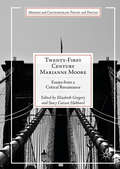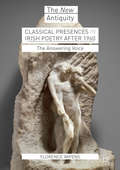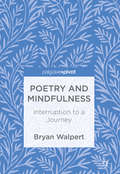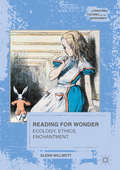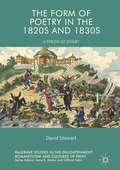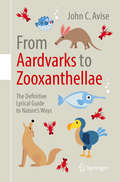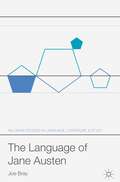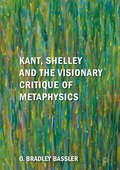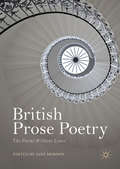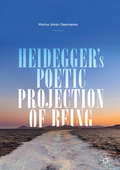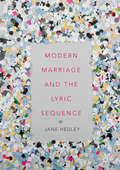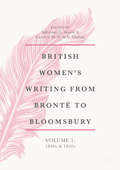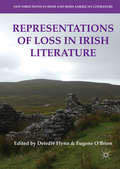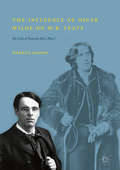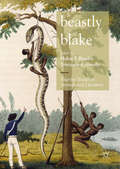- Table View
- List View
Twenty-First Century Marianne Moore: Essays from a Critical Renaissance
by Elizabeth Gregory Stacy Carson HubbardThis collection represents a new range of critical awareness and marks the burgeoning of what is a twenty-first-century Marianne Moore renaissance. The essays explore Moore’s participation in modernist movements and communities, her impact on subsequent generations of artists, and the dynamics of her largely disregarded post-World War II career. At the same time, they track the intersection of the evolution of her poetics with cultural politics across her career. Drawing on fresh perspectives from previously unknown biographical material and new editions and archives of Moore’s work, the essays offer particularly interesting insights on Moore’s relationships and her late career role as a culture icon.
Classical Presences in Irish Poetry after 1960: The Answering Voice
by Florence ImpensThis book provides the first overview of classical presences in Anglophone Irish poetry after 1960. Featuring detailed studies of Seamus Heaney, Michael Longley, Derek Mahon, and Eavan Boland, including close readings of key poems, it highlights the evolution of Irish poetic engagements with Greece and Rome in the last sixty years. It outlines the contours of a ‘movement’ which has transformed Irish poetry and accompanied its transition from a postcolonial to a transnational model, from sporadic borrowings of images and myths in the poets’ early attempts to define their own voices, to the multiplication of classical adaptations since the late 1980s -- at first at a time of personal and political crises, notably in Northern Ireland, and more recently, as manifestations of the poets’ engagements with European and other foreign literatures.
Classical Presences in Irish Poetry after 1960: The Answering Voice
by Florence ImpensThis book provides the first overview of classical presences in Anglophone Irish poetry after 1960. Featuring detailed studies of Seamus Heaney, Michael Longley, Derek Mahon, and Eavan Boland, including close readings of key poems, it highlights the evolution of Irish poetic engagements with Greece and Rome in the last sixty years. It outlines the contours of a ‘movement’ which has transformed Irish poetry and accompanied its transition from a postcolonial to a transnational model, from sporadic borrowings of images and myths in the poets’ early attempts to define their own voices, to the multiplication of classical adaptations since the late 1980s -- at first at a time of personal and political crises, notably in Northern Ireland, and more recently, as manifestations of the poets’ engagements with European and other foreign literatures.
Poetry and Mindfulness: Interruption to a Journey
by Bryan WalpertAt a time when the Humanities are under threat, this book offers a defense of poetry within the context of growing interest in mindfulness in business, health care, and education. The book argues that the benefits and insights mindfulness provides are also cultivated by the study of poetry. These benefits include a focus on the present, the ability to see through scripts and habits, a rethinking of subjectivity, and the development of ecological or systems thinking. Bryan Walpert employs close readings of traditional and experimental poetry and draws on scientific studies of the effects of mindfulness or reading literature on the brain. It argues the skills that poetry, like mindfulness, cultivates are useful beyond the page or classroom and ultimately are necessary to engage with such global issues as the environmental crisis.
Poetry and Mindfulness: Interruption to a Journey
by Bryan WalpertAt a time when the Humanities are under threat, this book offers a defense of poetry within the context of growing interest in mindfulness in business, health care, and education. The book argues that the benefits and insights mindfulness provides are also cultivated by the study of poetry. These benefits include a focus on the present, the ability to see through scripts and habits, a rethinking of subjectivity, and the development of ecological or systems thinking. Bryan Walpert employs close readings of traditional and experimental poetry and draws on scientific studies of the effects of mindfulness or reading literature on the brain. It argues the skills that poetry, like mindfulness, cultivates are useful beyond the page or classroom and ultimately are necessary to engage with such global issues as the environmental crisis.
Reading for Wonder: Ecology, Ethics, Enchantment
by Glenn WillmottIn a world awash in awesome, sensual technological experiences, wonder has diverse powers, including awakening us to unexpected ecological intimacies and entanglements. Yet this deeply felt experience—at once cognitive, aesthetic, and ethical—has been dangerously neglected in our cultural education. In order to cultivate the imaginative empathy and caution this feeling evokes, we need to teach ourselves and others to read for wonder. This book begins by unfolding the nature and artifice of wonder as a human capacity and as a fabricated experience. Ranging across poetry, foodstuffs, movies, tropical islands, wonder cabinets, apes, abstract painting, penguins and more, Reading for Wonder offers an anatomy of wonder in transmedia poetics, then explores its ethical power and political risks from early modern times to the present day. To save ourselves and the teeming life of our planet, indeed to flourish, we must liberate wonder from ideologies of enchantment and disenchantment, understand its workings and their ethical ambivalence, and give it a clear language and voice.
Reading for Wonder: Ecology, Ethics, Enchantment
by Glenn WillmottIn a world awash in awesome, sensual technological experiences, wonder has diverse powers, including awakening us to unexpected ecological intimacies and entanglements. Yet this deeply felt experience—at once cognitive, aesthetic, and ethical—has been dangerously neglected in our cultural education. In order to cultivate the imaginative empathy and caution this feeling evokes, we need to teach ourselves and others to read for wonder. This book begins by unfolding the nature and artifice of wonder as a human capacity and as a fabricated experience. Ranging across poetry, foodstuffs, movies, tropical islands, wonder cabinets, apes, abstract painting, penguins and more, Reading for Wonder offers an anatomy of wonder in transmedia poetics, then explores its ethical power and political risks from early modern times to the present day. To save ourselves and the teeming life of our planet, indeed to flourish, we must liberate wonder from ideologies of enchantment and disenchantment, understand its workings and their ethical ambivalence, and give it a clear language and voice.
The Form of Poetry in the 1820s and 1830s: A Period of Doubt
by David StewartThe 1820s and 1830s, the gap between Romanticism and Victorianism, continues to prove a difficulty for scholars. This book explores and recovers a neglected culture of poetry in those years, and it demonstrates that that culture was a crucial turning point in literary history. It explores a uniquely wide range of poets, including the poetry of the literary annuals, Letitia Landon, Felicia Hemans, Robert Browning, Samuel Taylor Coleridge, Thomas Hood and John Clare, placing their work in the light of new research into the conditions of the literary market. In turn, it uses that culture to open up wider theoretical issues relating to literary form, book history, print culture, gender and periodisation. The period’s doubt about poetry’s place in culture and its capacity to last prompted a dazzling range of creative experiments that reimagined the metrical, material and commercial forms of poetry.
The Form of Poetry in the 1820s and 1830s: A Period of Doubt
by David StewartThe 1820s and 1830s, the gap between Romanticism and Victorianism, continues to prove a difficulty for scholars. This book explores and recovers a neglected culture of poetry in those years, and it demonstrates that that culture was a crucial turning point in literary history. It explores a uniquely wide range of poets, including the poetry of the literary annuals, Letitia Landon, Felicia Hemans, Robert Browning, Samuel Taylor Coleridge, Thomas Hood and John Clare, placing their work in the light of new research into the conditions of the literary market. In turn, it uses that culture to open up wider theoretical issues relating to literary form, book history, print culture, gender and periodisation. The period’s doubt about poetry’s place in culture and its capacity to last prompted a dazzling range of creative experiments that reimagined the metrical, material and commercial forms of poetry.
From Aardvarks to Zooxanthellae: The Definitive Lyrical Guide to Nature’s Ways
by John C. AviseHundreds of animal species provide the cast of characters for these newly composed bio-limericks, arranged into 17 chapters by taxonomic group (such as Birds, Fishes, Insects) or biological subject (such as Ecology, Genetics, and Anthropology). Sometimes multiple verses on one organism or topic provide an extended story-line across successive poems. In addition, several stylistic vignettes recur throughout the book, such as: (a) “On the Farm”, which ranges from barnyards to fish farms to oyster farms; and (b) “Let’s Play Jeopardy”, where the reader guesses an animal from poetic clues the author provides. Each little jingle can be read as a stand-alone offering a quick chuckle or biological insight. But watch out—these poetic tidbits can be as addictive as popcorn, such that some readers will feel compelled to consume each chapter and indeed the entire book at one sitting! Covering nearly every creature that any amateur or professional biologist has ever heard of, these pun-filled limericks provide humorous insight into each critter or its peculiar habits, in a sharply witty and cutely informative way.
The Language of Jane Austen (Language, Style and Literature)
by Joe BrayJoe Bray’s careful analysis of Jane Austen’s stylistic techniques reveals that the genius of her writing is far from effortless; rather he makes the case for her as a meticulous craftswoman and a radical stylistic pioneer. Countering those who have detected in her novels a dominant, authoritative perspective, Bray begins by highlighting the complex, ever-shifting and ambiguous nature of the point of view through which her narratives are presented. This argument is then advanced through an exploration of the subtle representation of speech, thought and writing in Austen’s novels. Subsequent chapters investigate and challenge the common critical associations of Austen’s style with moral prescriptivism, ideas of balance and harmony, and literal as opposed to figurative expression. The book demonstrates that the wit and humour of her fiction is derived instead from a complex and subtle interplay between different styles. This compelling reassessment of Austen’s language will offer a valuable resource for students and scholars of stylistics, English literature and language and linguistics.
Kant, Shelley and the Visionary Critique of Metaphysics
by O. Bradley BasslerThis book addresses the philosophy of Kant and the poetry of Shelley as historical starting points for a new way of thinking in the modern age. Fusing together critical philosophy and visionary poetry, Bassler develops the notion of visionary critique, or paraphysics, as a model for future philosophical endeavor. This philosophical practice is rooted in the concept of the indefinite power associated with the sublime in both Kant and Shelley’s work, to which the notion of the parafinite or indefinitely large is extended in this book.
Kant, Shelley and the Visionary Critique of Metaphysics
by O. Bradley BasslerThis book addresses the philosophy of Kant and the poetry of Shelley as historical starting points for a new way of thinking in the modern age. Fusing together critical philosophy and visionary poetry, Bassler develops the notion of visionary critique, or paraphysics, as a model for future philosophical endeavor. This philosophical practice is rooted in the concept of the indefinite power associated with the sublime in both Kant and Shelley’s work, to which the notion of the parafinite or indefinitely large is extended in this book.
British Prose Poetry: An Anthology Of Contemporary British Prose Poetry
by Jane MonsonThis book is the first collection of essays on the British prose poem. With essays by leading academics, critics and practitioners, the book traces the British prose poem’s unsettled history and reception in the UK as well as its recent popularity. The essays cover the nineteenth, twentieth and twenty-first centuries exploring why this form is particularly suited to the modern age and yet can still be problematic for publishers, booksellers and scholars. Refreshing perspectives are given on the Romantics, Modernists and Post-Modernists, among them Woolf, Beckett and Eliot as well as more recent poets like Seamus Heaney, Geoffrey Hill, Claudia Rankine, Jeremy Over and Vahni Capildeo. British Prose Poetry moves from a contextual overview of the genre’s early volatile and fluctuating status, through to crucial examples of prose poetry written by established Modernist, surrealist and contemporary writers. Key questions around boundaries are discussed more generally in terms of race, class and gender. The British prose poem’s international heritage, influences and influence are explored throughout as an intrinsic part of its current renaissance.
British Prose Poetry: The Poems Without Lines (PDF)
by Editor Jane MonsonThis book is the first collection of essays on the British prose poem. With essays by leading academics, critics and practitioners, the book traces the British prose poem’s unsettled history and reception in the UK as well as its recent popularity. The essays cover the nineteenth, twentieth and twenty-first centuries exploring why this form is particularly suited to the modern age and yet can still be problematic for publishers, booksellers and scholars. Refreshing perspectives are given on the Romantics, Modernists and Post-Modernists, among them Woolf, Beckett and Eliot as well as more recent poets like Seamus Heaney, Geoffrey Hill, Claudia Rankine, Jeremy Over and Vahni Capildeo. British Prose Poetry moves from a contextual overview of the genre’s early volatile and fluctuating status, through to crucial examples of prose poetry written by established Modernist, surrealist and contemporary writers. Key questions around boundaries are discussed more generally in terms of race, class and gender. The British prose poem’s international heritage, influences and influence are explored throughout as an intrinsic part of its current renaissance.
Heidegger's Poetic Projection of Being
by Marius Johan GeertsemaThis book investigates the relationship between poetry and ontology in the works of Martin Heidegger. It explains the way in which Heidegger’s dialogue with poetry forms an essential step on the path of overcoming metaphysics and thinking the openness of presence. Heidegger’s engagement with poetry is an important moment in the development of his philosophy—or rather thinking of Being. Being speaks itself poetically in his view. Rather than a logician or a thinker, Being is the first poet.
Heidegger's Poetic Projection of Being
by Marius Johan GeertsemaThis book investigates the relationship between poetry and ontology in the works of Martin Heidegger. It explains the way in which Heidegger’s dialogue with poetry forms an essential step on the path of overcoming metaphysics and thinking the openness of presence. Heidegger’s engagement with poetry is an important moment in the development of his philosophy—or rather thinking of Being. Being speaks itself poetically in his view. Rather than a logician or a thinker, Being is the first poet.
Modern Marriage and the Lyric Sequence
by Jane HedleyModern Marriage and the Lyric Sequence investigates the ways in which some of our best poets writing in English have used poetic sequences to capture the lived experience of marriage. Beginning in 1862 with George Meredith’s Modern Love, Jane Hedley’s study utilizes the rubrics of temporality, dialogue, and triangulation to bring a deeply rooted and vitally interesting poetic genre into focus. Its twentieth- and twenty-first-century practitioners have included Edna St. Vincent Millay, Robert Lowell, Rita Dove, Eavan Boland, Louise Glück, Anne Carson, Ted Hughes, Claudia Emerson, Rachel Zucker, and Sharon Olds. In their poetic sequences the flourishing or failure of a particular marriage is always at stake, but as that relationship plays out over time, each sequence also speaks to larger questions: why we marry, what a marriage is, what our collective stake is in other people’s marriages. In the book’s final chapter gay marriage presents a fresh testing ground for these questions, in light of the US Supreme Court’s affirmation of same-sex marriage.
Modern Marriage and the Lyric Sequence (PDF)
by Jane HedleyModern Marriage and the Lyric Sequence investigates the ways in which some of our best poets writing in English have used poetic sequences to capture the lived experience of marriage. Beginning in 1862 with George Meredith’s Modern Love, Jane Hedley’s study utilizes the rubrics of temporality, dialogue, and triangulation to bring a deeply rooted and vitally interesting poetic genre into focus. Its twentieth- and twenty-first-century practitioners have included Edna St. Vincent Millay, Robert Lowell, Rita Dove, Eavan Boland, Louise Glück, Anne Carson, Ted Hughes, Claudia Emerson, Rachel Zucker, and Sharon Olds. In their poetic sequences the flourishing or failure of a particular marriage is always at stake, but as that relationship plays out over time, each sequence also speaks to larger questions: why we marry, what a marriage is, what our collective stake is in other people’s marriages. In the book’s final chapter gay marriage presents a fresh testing ground for these questions, in light of the US Supreme Court’s affirmation of same-sex marriage.
British Women's Writing from Brontë to Bloomsbury, Volume 1: 1840s and 1850s (British Women’s Writing from Brontë to Bloomsbury, 1840-1940 #1)
by Adrienne E. Gavin Carolyn W. de la L. OultonThis five-volume series, British Women’s Writing From Brontë to Bloomsbury, 1840-1940, historically contextualizes and traces developments in women’s fiction from 1840 to 1940. Critically assessing both canonical and lesser-known British women’s writing decade by decade, it redefines the landscape of women’s authorship across a century of dynamic social and cultural change. With each of its volumes devoted to two decades, the series is wide in scope but historically sharply defined. Volume 1: 1840s and 1850s inaugurates the series by historically and culturally contextualizing Victorian women’s writing distinctly within the 1840s and 1850s. Using a range of critical perspectives including political and literary history, feminist approaches, disability studies, and the history of reading, the volume’s 16 original essays consider such developments as the construction of a post-Romantic tradition, the politicization of the domestic sphere, and the development of crime and sensation writing. Centrally, it reassesses key mid-nineteenth-century female authors in the context in which they first published while also recovering neglected women writers who helped to shape the literary landscape of the 1840s and 1850s.
Representations of Loss in Irish Literature (New Directions in Irish and Irish American Literature)
by Deirdre Flynn Eugene O'BrienThis is the first book on Irish literature to focus on the theme of loss, and how it is represented in Irish writing. It focuses on how literature is ideally suited to expressions and understanding of the nature of loss, given its ability to access and express emotions, sensations, feelings, and the visceral and haptic areas of experience. Dealing with feelings and with sensations, poems, novels and drama can allow for cathartic expressions of these emotions, as well as for a fuller understanding of what is involved in loss across all situations. The main notion of loss being dealt with is that of death, but feelings of loss in the wake of immigration and of the loss of certainties that defined notions of identity are also analysed. This volume will be of interest to scholars, students and researchers in Irish Studies, loss, memory, trauma, death, and cultural studies.
Representations of Loss in Irish Literature (New Directions in Irish and Irish American Literature)
by Deirdre Flynn Eugene O'BrienThis is the first book on Irish literature to focus on the theme of loss, and how it is represented in Irish writing. It focuses on how literature is ideally suited to expressions and understanding of the nature of loss, given its ability to access and express emotions, sensations, feelings, and the visceral and haptic areas of experience. Dealing with feelings and with sensations, poems, novels and drama can allow for cathartic expressions of these emotions, as well as for a fuller understanding of what is involved in loss across all situations. The main notion of loss being dealt with is that of death, but feelings of loss in the wake of immigration and of the loss of certainties that defined notions of identity are also analysed. This volume will be of interest to scholars, students and researchers in Irish Studies, loss, memory, trauma, death, and cultural studies.
The Influence of Oscar Wilde on W.B. Yeats: "An Echo of Someone Else’s Music"
by Noreen DoodyThis book asserts that Oscar Wilde (1854 – 1900) was a major precursor of W.B. Yeats (1865 – 1939), and shows how Wilde’s image and intellect set in train a powerful influence within Yeats’s creative imagination that remained active throughout the poet’s life. The intellectual concepts, metaphysical speculations and artistic symbols and images which Yeats appropriated from Wilde changed the poet’s perspective and informed the imaginative system of beliefs that Yeats formulated as the basis of his dramatic and poetic work.Section One, 'Influence and Identity' (1888 – 1895), explores the personal relationship of these two writers, their nationality and historical context as factors in influence. Section Two, 'Mask and Image' (1888 – 1917), traces the creative process leading to Yeats’s construction of the antithetical mask, and his ideas on image, in relation to the role of Wilde as his precursor. Finally, 'Salomé: Symbolism, Dance and Theories of Being' (1891 – 1939) concentrates on the immense influence that Wilde’s symbolist play, Salomé, wrought on Yeats’s imaginative work and creative sensibility.
The Influence of Oscar Wilde on W.B. Yeats: "An Echo of Someone Else’s Music"
by Noreen DoodyThis book asserts that Oscar Wilde (1854 – 1900) was a major precursor of W.B. Yeats (1865 – 1939), and shows how Wilde’s image and intellect set in train a powerful influence within Yeats’s creative imagination that remained active throughout the poet’s life. The intellectual concepts, metaphysical speculations and artistic symbols and images which Yeats appropriated from Wilde changed the poet’s perspective and informed the imaginative system of beliefs that Yeats formulated as the basis of his dramatic and poetic work.Section One, 'Influence and Identity' (1888 – 1895), explores the personal relationship of these two writers, their nationality and historical context as factors in influence. Section Two, 'Mask and Image' (1888 – 1917), traces the creative process leading to Yeats’s construction of the antithetical mask, and his ideas on image, in relation to the role of Wilde as his precursor. Finally, 'Salomé: Symbolism, Dance and Theories of Being' (1891 – 1939) concentrates on the immense influence that Wilde’s symbolist play, Salomé, wrought on Yeats’s imaginative work and creative sensibility.
Beastly Blake (Palgrave Studies in Animals and Literature)
by Helen P. Bruder Tristanne ConnollyBlake’s ‘Human Form Divine’ has long commanded the spotlight. Beastly Blake shifts focus to the non-human creatures who populate Blake’s poetry and designs. The author of ‘The Tyger’ and ‘The Lamb’ was equally struck by the ‘beastliness’ and the beauty of the animal kingdom, the utter otherness of animal subjectivity and the meaningful relationships between humans and other creatures. ‘Conversing with the Animal forms of wisdom night & day’, Blake fathomed how much they have to teach us about creation and eternity. This collection ranges from real animals in Blake’s surroundings, to symbolic creatures in his mythology, to animal presences in his illustrations of Virgil, Dante, Hayley, and Stedman. It makes a third to follow Queer Blake and Sexy Blake in irreverently illuminating blind spots in Blake criticism. Beastly Blake will reward lovers of Blake’s writing and visual art, as well as those interested in Romanticism and animal studies.
